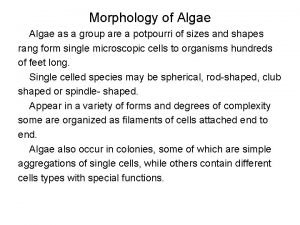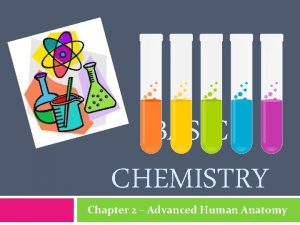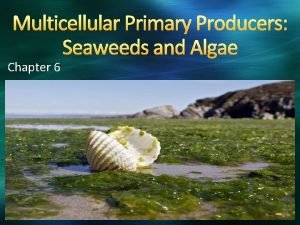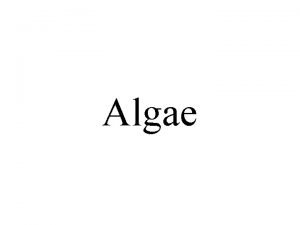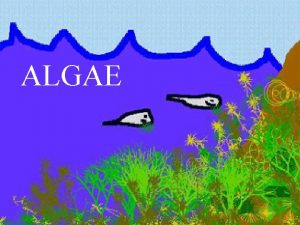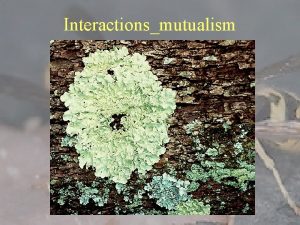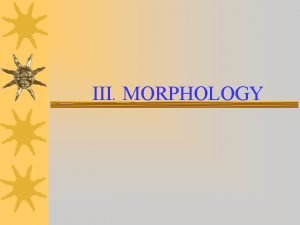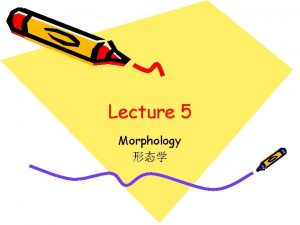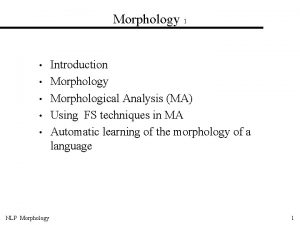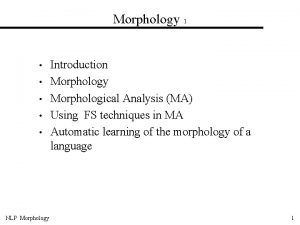Morphology of Algae as a group are a















- Slides: 15

Morphology of Algae as a group are a potpourri of sizes and shapes rang form single microscopic cells to organisms hundreds of feet long. Single celled species may be spherical, rod-shaped, club shaped or spindle- shaped. Appear in a variety of forms and degrees of complexity some are organized as filaments of cells attached end to end. Algae also occur in colonies, some of which are simple aggregations of single cells, while others contain different cells types with special functions.

Morphology of Protozoa Some protozoa are oval or spherical, other elongate still others are polymorphic, morphologically different format different stage of the life cycle. Cells can be as small as 1 um in diameter and as large as 2000 um or 2 mm ( visible without magnification). Protozoa lack cell wall, are able to move at some stage of their life cycle, and ingest particle of food. Consequently, many protozoan cell are more complex than other of cells. Some of the general characteristics that distinguish fungi, algae, and protozoa are summarized table 4. 1( copy p-136).

Ultra structure of Eukaryotic Microorganisms Flagella and cilia, originate from a basal body lying beneath the membrane that encloses the all. Eukaryotic cilia, are identical to eukaryotic flagella in structure. Note a cell covered with cilia looks like a porcupine a large number of the protozoa species have this appearance. ATP the energy to move prokaryotic Cell wall Plants, algae, and fungi have cell wall. (Note: eukaryotic cell do not)

Maintain the shape of cells and prevents then from bursting through osmotic pressure. In plants the cell wall is rigid, composed of polysaccharide such as cellulose and protein. Cytoplasm Membrane Whether or not a eve argotic cell wall, it has a cytoplasmic membrane, that encloses the main body of the cell the semipermeable membrane. However, there are differences between prokaryotic and euearyotic eytoplasmic member

The eucaryotic eytoplasmic membrane- sterol (cholesterol) the procaryotic membrane generally does not Cellular organelles Inside the eytoplasmic membrane is the protein divided into the karyoplasm and the egtoplasm rich in chimical, the cellular organelles proearyotic # eucaryotic eytoplasme an extensive network of microtubules and protein structure. Nuclevs The nucleor membrane contains numerous large pres through which substances such as proteins and RNA DNA, basic proteins, such as histones, chromatin RNA

Endoplasmic Retiaulum is a membranous network of flatlened sacs and tubules Golgi Complex is composed of flatlened membranous sac, have spherical vasicles at their tips. Lysosome, enzyme catalyze hydrolytic protease, nuclease, glycosidases, sulfates, lipase and phosphatase. Contains glycosyltransferase enzymes, atlach carbohydrate, gluaose.

Mitochonodria Active in a cell require energy. the energy rich molecules of adenosine tri phosphate (ATP) biochemical process (acrobrc respiration) Cloroplasts alga have another energy- generating cytoplasmic the side of photosynthetic reaction.

Dormant form of eucaryotic Microorganisms Some microorganism can produce dormant forms called spores and cysts. Both fungi and protozoa, include species that use such resting structures for protection and reproduction. Algae form spore for reproduction but do not form cysts spores Fung: produce both sexual and spores Sexual spore- a result of the fusion of two specislized reproductive cells called gametes. For example spores of Penicillium notatum colonies- are blue- green.

Spore Aspergillus niger are black Asexual spore produced by the aerial hyphae, disseminate the species. Cyst Many protozon produce resting forms called cysts

Nutritional Requirements and Microbiological Media Of all living organisms, microorganisms are the most versatile and diversified in their nutritional requirements. Sometimes microorganisms are studied in their natural habitats. Chemical elements as nutrients. In order to grow all organisms need a variety of chemical elements as nutrients. Carbon is one of the most important chemical elements required for microbial growth. All organisms require carbon in some form, organic compounds as their major carbon source Autotrophs: microorganism that use carbon diocide as their major or even soke source of carbon.

Nitrogen (155) All organisms also require nitrogen in some form the element is an essential part of amino acid that together form proteins. Note: some bacteria can use atmospheric or gacous nitrogen for cell synthesis through a process called nitrogen fixation Hydrogen, Oxygen, sulfur, and phosphorus. Other elements essential to all organism are by Hydrogen, Oxygen, sulfur and phosphorus. Hydrogen and Oxygen form part of many organic compounds.

• Hydrogen and Oxygen form part of many organic compounds. • Sulfur is needed for the biosynthesis of amino acids. Cyteire, Cytine and methionine. • Phosphorus is essential for the synthesis of nucleic acids and adenosine triphosphate (ATP) , for energy storage and transfer • Inorganic ions such as sulfate (SO) and phosphate (PO) can also supply the main element needed by microorganisms • Other Elements Na, Fe, Zn, Cu, Mn, Mo, Co

Nutritional classification of Micro organisms • Chemothophs: organisms that use chemical compounds for energy. • Phototrophs depend primarily on radiant energy (light) by combining these terms. 1. Chemoavtotrophs use chemical substances (inorganic). Ex earbon dioxide 2. Chemoheterotrophs use chemical substanu (organic)

3. Photoavtotrophs use light as a source of energy and carbondioxide as the main source of carbon. 4. Photoheterotrophs use light as a source of energy and organic compounds as the main source of carbon. Media Used For Cultivating Micro Organisms Chemically defined media are used (copy page 158) Minimal medium anthranilic indole trytophan

The API 20 E system show here is for the identification of bacteria in the family. Media for the Growth of bacteria If glvcose is a common constitvent of a bacterial environment, then the sugar is added to the culture medium. Copy p 16.
 Antigentest åre
Antigentest åre Morphology of algae
Morphology of algae Derivational morphology and inflectional morphology
Derivational morphology and inflectional morphology Sumner's classification of social groups
Sumner's classification of social groups Primary group
Primary group Amino group and carboxyl group
Amino group and carboxyl group Two factor theory psychology
Two factor theory psychology Joining together group theory and group skills
Joining together group theory and group skills Group 1 vs group 2 specialties
Group 1 vs group 2 specialties In group out group
In group out group Within group variance vs between group
Within group variance vs between group Lattice energy trend
Lattice energy trend Group yourself or group yourselves
Group yourself or group yourselves Anova within group and between group
Anova within group and between group Amino group and carboxyl group
Amino group and carboxyl group Brown algae
Brown algae

